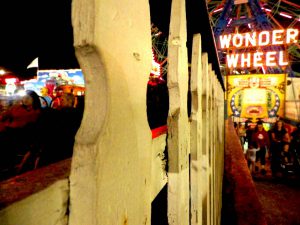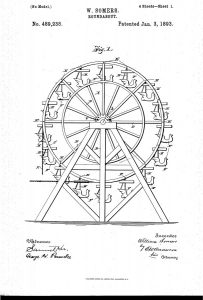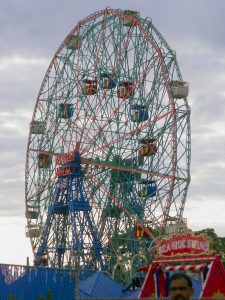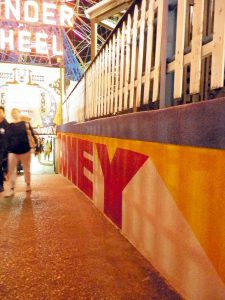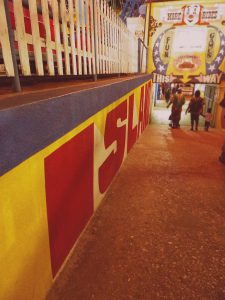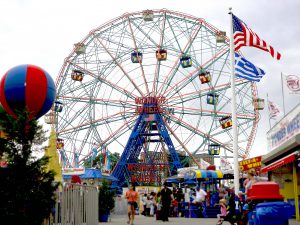If anyone would ask eight year old Sabrina what was the scariest amusement park ride she could possibly think of, she would have replied with a very unoriginal kid-type of answer, any crazy roller coaster with all types of loops and anti-gravity. If someone were to propose the same question now, I would answer with The Wonder Wheel or any other Ferris wheel similar to this childhood joy. Something about being flimsily locked into a cage and being rotated and swung, about one hundred fifty feet in the air makes me a bit queasy.
The first stop in the history of Deno’s Wonder Wheel is placed in Atlantic City, New Jersey in 1891 when a carpenter by the name of William Somers placed a file patenting a structure he called a “Roundabout.” He was mass making these Roundabouts for local amusement parks in Atlantic City, Asbury, and Coney Island. His structure was made of wood and lifted its riders fifty feet in the air. Somers wanted to publicize his invention and was the first to patent this idea. With the help of Google Patents which transcribes patents to viewable versions for the internet, I was able to find Somer’s Patent, US489238. It includes his structural drawings to concisely prove the concept of his invention. This is the first patent regarding the Roundabout and all of its successors.
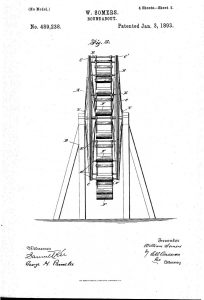
Image Credit: Google Patent
According to Smithsonian.com In 1890 architect and urban planner, Daniel Burnham (whom I’ve mentioned in a past post for creating the Flatiron Building), was commissioned to be the Director of Works for the World’s fair of 1893 in Chicago. The city hoped to have him present America with its own version of the beautiful Eiffel Tower. Desperate for an answer to the city’s need, Burnham held his own contest with engineers to invent something that would be the show-stopping piece for the fair. As a response to Burnham’s request, George Washington Gale Ferris Jr., a thirty-three year old engineer native to Pittsburgh, came up with an idea for a pleasure wheel much akin to Somer’s Roundabout although his would be illuminated and made of steel which increased the diameter of fifty feet to two hundred fifty feet. It would be delicate and tensile, Ferris thought it was perfect for the program but Burnham shot down his idea since he felt that it was too fragile to safely carry passengers at that height. Instead of giving up on his dream, Ferris commissioned the project by himself with twenty-five thousand dollars. On June 21, 1893 he debuted his structure as the Eiffel Tower of the fair; it was a success. From then on, Somers was forgotten in the public eye and we now refer to Roundabouts as Ferris Wheels.
On Memorial Day of 1920 Charles Herman, engineer, opened a Ferris wheel to the public. Its conception took about nineteen months with the help of the Eccentric Ferris Wheel Company. it was one hundred fifty feet in diameter and could have as many as one hundred forty-four passengers at maximum capacity. This two hundred ton beauty had a total of twenty-four cars (sixteen stationary cars which are on the outer circle of the wheel and eight cars that rock for the real thrill-seekers which are in the center) all of which could hold up to six people. Herman named the wheel “Dip-the-Dip” and it remained in his service and care for the next years until his death. His son Fred Garms took over the legacy and took care of the ride while making his own additions, like the “Spook-a-rama”. In 1983, Garms sold the rides to a Greek born immigrant by the name of Constantinos Dionysios “Deno” Vourderis for two hundred fifty thousand dollars.
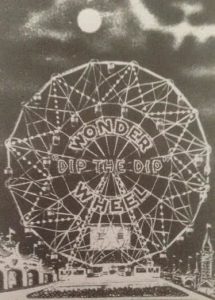
Image Credit: Atlas Obscura
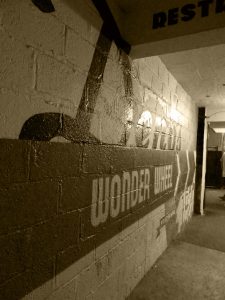
This is where the name that we all grew up with, comes into light, “Deno’s Wonder Wheel Amusement Park”. In 1948, Deno had proposed to his wife in front of the Wonder Wheel; in addition to promising to love and stand by her for the rest of his life, he also promised to buy the Wonder Wheel, one day, and buy her a ring she deserved; he kept those promises. In 1994, Deno passed away leaving his sons to take on his legacy just as Herman and his son.
To this day, The Wonder Wheel has a perfect safety record after ninety-seven years in business and is the best example of care for an amusement park ride. It is also deemed the most romantic ride since it’s seen many proposals. The public loved the ride so much that there are two known replicas in California and Japan.
From family to family the Wonder Wheel was passed and every owner deeply cared for it; having this remarkable desire to keep everyone safe by maintaining the wheel’s health.


